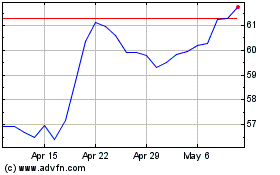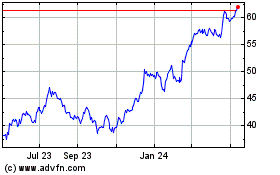Wells Fargo Reports Decrease in Earnings--2nd Update
January 13 2017 - 9:48AM
Dow Jones News
By Emily Glazer
Wells Fargo & Co. reported a decline in fourth-quarter
profit as moves in interest rates, a falloff in mortgage revenue
and the bank's recent sales-tactics scandal weighed on the nation's
third-largest bank.
Shares fell about 1% in premarket trading after the results were
announced.
The San Francisco-based bank reported a profit of $5.27 billion,
or 96 cents a share. That compares with $5.58 billion, or $1 a
share, in the same period of 2015. Analysts polled by Thomson
Reuters had expected earnings of $1 a share.
Wells Fargo noted that its earnings were hurt by what it called
"hedge ineffectiveness," which related to the way it protects
against swings in interest rates. The ineffective hedge reduced
earnings by 7 cents a share. Earlier in 2016, this protection had
led to a gain.
Revenue slipped to $21.582 billion from $21.586 billion, below
the average analyst estimate of $22.45 billion.
The fourth quarter was the first three-month period to start
after the regulatory fine was imposed. In September, the bank
agreed to a $185 million settlement with two regulators and a city
official over opening as many as 2.1 million accounts with
fictitious or unauthorized information.
Since the scandal, new retail banking business such as customer
checking account openings and credit card applications have fallen
dramatically, including a drop of 40% and 43%, respectively, in
December from a year ago.
Overall profits at Wells Fargo's community banking division,
which includes the unit responsible for the questionable sales
tactics, were $2.73 billion, a 15% decrease from the $3.3 billion
it earned in the fourth quarter of 2015.
The scandal has boosted expenses, which are likely to remain
high for some time. Wells Fargo CEO Timothy Sloan has said the bank
expects to spend tens of millions of dollars to get through
investigations and other regulatory matters related to its
sales-practices scandal. Wells faces a spate of state and federal
investigations, including by the Justice Department and the
Securities and Exchange Commission.
Making matters worse, the higher costs come as interest rates
remain at relatively low levels, despite a recent uptick. The
result of this combination: Wells Fargo's return on equity
continues to grind lower in the fourth quarter, at 10.94%, its
lowest level in years.
In coming quarters, Wells Fargo and other big banks hope that
interest rates continue climbing, as they did in the fourth quarter
on the back of the Federal Reserve's second interest-rate bump
since the financial crisis. Big banks earn more money by lending
out their vast deposits when interest rates rise and there is a
larger gap between short-term and long-term rates, a so-called
"steep" yield curve.
But low rates have been a boon for certain aspects of home
lending. Wells Fargo's mortgage business, the largest in the U.S.
by volume, earned $1.42 billion in fees in the fourth quarter,
falling 15% from the $1.66 billion it earned in same period a year
ago. The bank extended $72 billion in home loans between the end of
September and the end of December, compared with $47 billion in the
fourth quarter of 2015 and $70 billion in the third quarter of
2016.
Total costs at Wells Fargo decreased 1% to $13.2 billion from
$13.3 billion in the third quarter of 2016. Expenses as a share of
revenue in the fourth quarter was 61.2%, above the 55%-59% range
that Wells Fargo targets for its so-called "efficiency ratio." The
bank said it expects the efficiency ratio to "remain at an elevated
level," partly because of costs related to the sales scandal.
Despite overall loan growth, Wells Fargo reported that the
profitability of its lending activities continued to be challenged.
Its net interest margin, a measure of how profitably it can lend
out its customers' deposits, grew to 2.87% from 2.82% at the end of
September and 2.92% in the fourth quarter a year ago.
Wells Fargo had been one of the most consistent big banks at
growing earnings and revenue. That momentum has been hit by the
sales-practices scandal. In addition, regulators last month said
the bank failed its so-called living will regulatory test of how
the bank could unwind in a crisis scenario.
Write to Emily Glazer at emily.glazer@wsj.com
(END) Dow Jones Newswires
January 13, 2017 09:33 ET (14:33 GMT)
Copyright (c) 2017 Dow Jones & Company, Inc.
Wells Fargo (NYSE:WFC)
Historical Stock Chart
From Mar 2024 to Apr 2024

Wells Fargo (NYSE:WFC)
Historical Stock Chart
From Apr 2023 to Apr 2024
